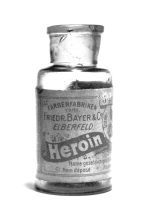Article
Natural and pharmaceutically-derived substances used to relieve pain that can cause stupor, sleep, euphoria, and addiction. The most common form of narcotics are opiates, such as opium, morphine, and heroin. Morphine was isolated from opium in 1804 by German pharmacist F.W.A. Sertürner, and heroin was developed from morphine in 1898 by the German pharmaceutical company Bayer.
All narcotics were initially developed and prescribed to manage pain. However, due to their highly addictive nature, narcotic abuse led to strict regulation and enforcement of the use of these and other substances. In the 1970s, the U.S. federal government engaged in the War on Drugs, which led to high rates of incarceration for populations who came to be associated with the criminal use of controlled substances, such as narcotics. Targeted populations included counterculture movements, the inner city poor, and the working poor, especially black and Latino communities.
"Pre-war Bayer heroin bottle, originally containing 5 grams of heroin" by Mpv_51 is licensed under Public Domain.
Manuscripts
A04 Dance Hall of the Dead (04-06) p. 72
A04 Dance Hall of the Dead (04-06) p. 107
A04 Dance Hall of the Dead (04-06) p. 108
A07 The Dark Wind (04-06), p. 28
A07 The Dark Wind (04-06), p. 47
A07 The Dark Wind (04-06), p. 65
A07 The Dark Wind (04-06), p. 86
A07 The Dark Wind (04-06), p. 97
A07 The Dark Wind (04-06), p. 117
A07 The Dark Wind (04-06), p. 127
A07 The Dark Wind (04-06), p. 145
A07 The Dark Wind (04-06), p. 150
A07 The Dark Wind (04-06), p. 152
A07 The Dark Wind (04-06), p. 155
A07 The Dark Wind (04-06), p. 156
A07 The Dark Wind (04-06), p. 159
A07 The Dark Wind (04-06), p. 164
A07 The Dark Wind (04-06), p. 175
A07 The Dark Wind (04-06), p. 227
A07 The Dark Wind (04-06), p. 275
References
Encyclopædia Britannica Online
N.d. Narcotic. http://www.britannica.com/EBchecked/topic/403484/narcotic, accessed
September 19, 2014.

